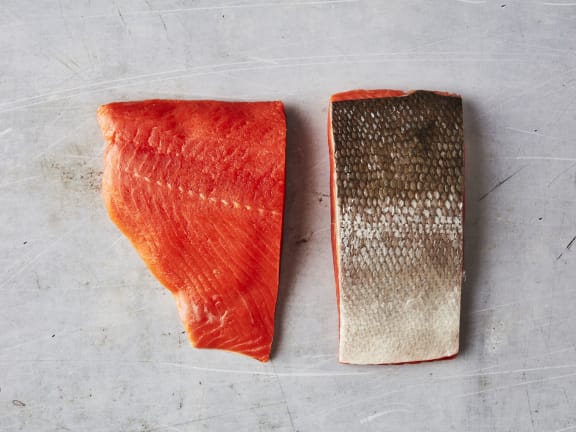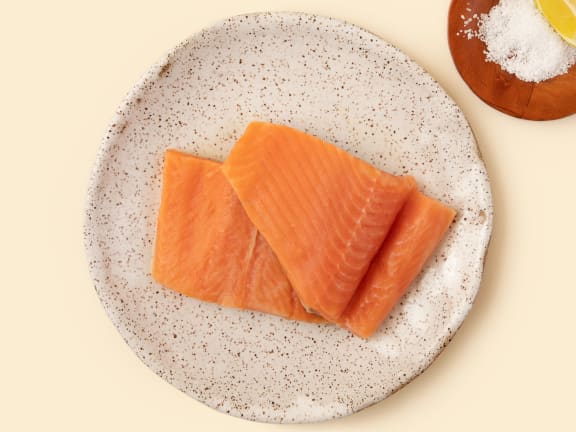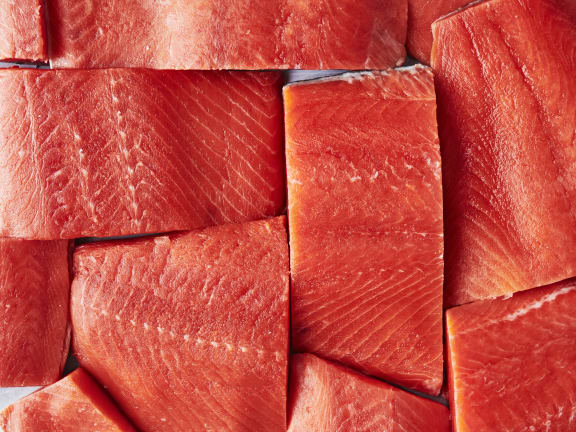Why are salmon orange, pink or red?
Have you ever heard that if you eat a bunch of carrots, you’ll turn orange? Salmon is orange, pink or even red for the same exact reason: they consume carotenoids, an antixodant that gives salmon its color. In the wild, salmon regularly consume a diet rich in a caratenoid called astaxanthin, and the natural color of salmon flesh reflects this. Farmed salmon, in contrast, get their carotenoids from manmade pellets.
What color are different types of wild-caught salmon?

In the wild, salmon get their characteristic hue from the creatures they eat — its what makes salmon red or pink. This unique color reflects this carnivore’s diet of shrimp and krill. Each species of salmon eats a different proportion of these carotenoid-rich crustaceans, which influences how red or pink they become. For example, sockeye tends to be the deepest in color because they feed heavily on carotenoid-rich zooplankton throughout their lifecycle, while coho salmon switch from zooplankton to small fish as they mature.
Because of this, coho tends to be pink or orange. King salmon, or chinook salmon, is also lighter in color than sockeye due to it's diet of small fish. Depending on where it's caught its color can range from orange to a subtle pink with gray tones.

Interestingly, king salmon can either be "red" or "white." King salmon can carry a recessive trait that leads to white or ivory flesh. In the past, fishermen and women used to prefer the king salmon they were more familiar with, but now wild-caught white king salmon is considered more of a delicacy. Now, does it taste the same as its more colorful counterpart? That’s up for debate.
Are farm-raised salmon dyed?
Farmed salmon is generally on the pinker side, also because of its diet, but not for the same reasons. Without shrimp or krill, farmed salmon can't consume naturally-occurring carotenoids. Without carotenoids, their flesh would look grey or beige, not pink or red. You wouldn't even be able to recognize these fillets as salmon.
So, do they dye salmon pink in salmon farms? Not exactly. In order to approximate what color salmon is supposed to be, farmed salmon are fed feed that has added dyes. Salmon farmers typically use corn and soy pellets that are supplemented with astaxanthin for this color — often, a synthetically derived source, rather than one that contains naturally occuring, nutrient-rich antioxidants. Why bother taking this extra, costly step? Because it sells.
According to research conducted by DSM, a company that supplies dye to salmon farmers, different intensities of salmon dye appeal to different consumer bases. DSM even offers a “SalmoFan” to their clients — kind of like a paint wheel — to help salmon farmers determine how much pigment to use in their fish feed in order to achieve a certain shade of pink. Industry research conducted by a group of Norwegian academics shows that when offered the choice, consumers associate quality with color and would be willing to pay more for richer shades of pink.
Since the color of farmed salmon can be manipulated, the shade of your fillet isn't always the best way to understand whether you're looking at farmed vs. wild salmon. To be a better educated consumer, learn about other ways to spot wild salmon vs. farmed, because seafood fraud in the U.S. is real.
Salmon Are What They Eat
So there you have it. Farmed or wild, a salmon’s color resembles what it eats. Shrimp and krill for wild and synthetic astaxanthin for farmed.
If you're ready to bring home some of the best wild-caught, sustainably harvested salmon on the planet — naturally vibrant in color and rich in nutrients — learn more about becoming a member of Wild Alaskan Company.






